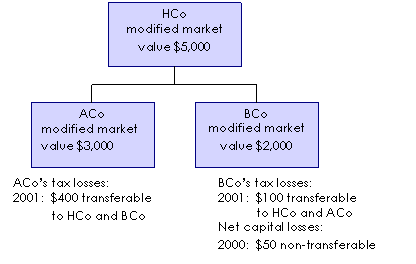Consolidation Reference Manual
You can still refer to the Consolidation reference manual for consolidation information that has not been impacted by changes in the legislation.
C3 Losses
C3-4 Worked example - loss utilisation
Applying the value donor concession
C3-4-210 Adding to modified market value to reflect loss transferability
Description
As shown in this example, a loss entity (the 'real loss-maker'), in calculating its available fraction, may add to its modified market value the modified market value of another company (the 'value donor'). Certain losses from the value donor are also able to be transferred notionally. This enables those losses to be utilised using the available fraction for the real loss-maker.
- •
- loss bundles and calculating the available fraction → 'Treatment of losses', C3-1 ; 'Consolidation loss provisions', C3-2-110 (high-level worked example)
- •
- working out modified market value → 'Modified market value of a single joining entity', C3-4-110 (worked example)
Commentary
Subdivision 707-C of the Income Tax (Transitional Provisions) Act 1997 sets out the operation of the value donor concession. In broad terms:
- •
- For a company to be a value donor, it must be a company to which the real loss-maker could have transferred, under the group loss transfer rules in Division 170 of the Income Tax Assessment Act 1997, at least one of the losses in its bundle.
- •
- To be eligible for the concession, both the real loss-maker and the value donor must be companies that join the group when it first consolidates, and the group must consolidate during the transitional period (that is, 1 July 2002 to 30 June 2004).
The head company may also treat one or more of the value donor's losses as if it was included in the real loss-maker's bundle for the purpose of determining the amount of the losses that can be utilised by the group in any given income year. Broadly, losses can be treated in this way only if they could be transferred from the value donor to the real loss-maker, and to any of the real loss-maker's other value donors, under the group loss transfer rules.
Example
Facts
A wholly-owned group consists of a head company, HCo, and two subsidiary companies. The group consolidates on 1 July 2002. At that time, the adjusted market value of the group (that is, the market value after ignoring any losses and assuming a nil franking account balance) is $10,000.
Figure 1: HCo and subsidiary members

Calculation
In the absence of the value donor concession, the available fractions for ACo and BCo would be 0.300 and 0.200 respectively. Under the concession, modified market value can be transferred to either ACo or BCo or both. A further concession under this subdivision allows losses to be transferred notionally for the purpose of determining their rate of utilisation.
This example will consider two of the options available to HCo under the value donor concession.
Transfer to ACo only (option 1)
ACo's only loss is transferable to HCo under the group loss transfer rules, so ACo can add a chosen percentage of HCo's modified market value when calculating its available fraction. Assume 100% of HCo's value is chosen to be added.
100% * $5,000 = $5,000
ACo's loss is also transferable to BCo, so ACo can add a chosen percentage of BCo's modified market value to its own when calculating its available fraction. Assume 50% of BCo's value is chosen to be added. This would allow some modified market value to remain with BCo to be used in determining an available fraction to allow utilisation of BCo's non-transferable loss.
50% * $2,000 = $1,000
Therefore, ACo's available fraction is now calculated as follows:
($3,000 + $5,000 + $1,000) , $10,000 = 0.900
HCo can treat BCo's transferable loss of $100 as if it was included in ACo's bundle for the purpose of determining how much of the loss can be utilised.
BCo's available fraction for its bundle containing the $50 non-transferable loss is calculated as follows:
[$2,000 - (50% * $2,000)] , $10,000 = 0.100
Transfer to BCo only (option 2)
BCo has a loss that is transferable to HCo, so BCo can add a portion of HCo's modified market value when calculating its available fraction. That portion is determined by multiplying the chosen percentage of HCo's modified market value by the proportion of BCo's total losses that is transferable to HCo. Assume that 100% of HCo's modified market value is chosen to be added.
(100% * $5,000) * (100 / 150) = $3,333
BCo also has a loss that is transferable to ACo, so BCo can add a portion of ACo's modified market value to its own when calculating its available fraction. The portion is calculated as follows (assuming that 100% of ACo's modified market value is chosen to be added):
(100% * $3,000) * (100 / 150) = $2,000
HCo can treat ACo's transferable loss of $400 as if it was included in BCo's bundle for the purpose of determining how much of the loss can be utilised.
BCo's available fraction is calculated as follows:
($2,000 + $3,333 + $2,000) , $10,000 = 0.733
All the losses in BCo's bundle, together with ACo's transferable loss, will be utilised with this available fraction.
References
Income Tax Assessment Act 1997, Division 170
Income Tax (Transitional Provisions) Act 1997, Subdivision 707-C; as amended by New Business Tax System (Consolidation) Act (No. 1) 2002 (No. 68 of 2002), Schedule 2
Explanatory Memorandum to the New Business Tax System (Consolidation) Bill (No. 1) 2002, Chapter 9
Current at 2 December 2002
Copyright notice
© Australian Taxation Office for the Commonwealth of Australia
You are free to copy, adapt, modify, transmit and distribute material on this website as you wish (but not in any way that suggests the ATO or the Commonwealth endorses you or any of your services or products).
